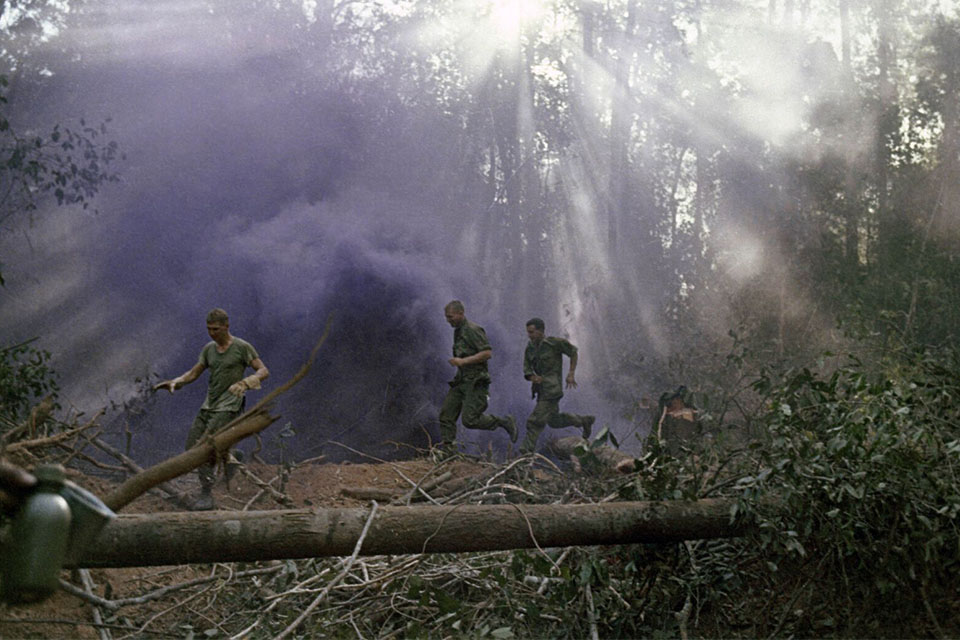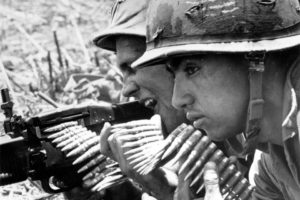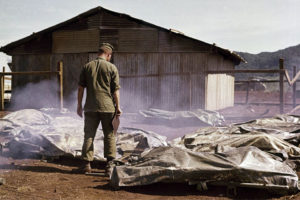A year before the famous 1968 siege of the remote American outpost, Marines fought a brutal struggle to seize its surrounding hills.
As Sergeant Donald E. Harper Jr. led his squad up a small rise during a routine patrol just west of the airstrip that served the Marine base camp at Khe Sanh, 50 North Vietnamese Army regulars hit the unit with small-arms fire, killing one American and wounding another. Harper pulled back and requested artillery support. After several artillery barrages and two ground assaults, the Marines finally took the height with heavy close-in fighting. The Marines, whose total losses for the day were one dead and 11 wounded, found nine enemy bodies, an 82mm mortar, mortar ammunition and range-finding equipment littering the mound.
That battle fought on Feb. 25, 1967, by Harper’s squad—from 2nd Platoon, Bravo Company, 1st Battalion, 9th Marine Regiment, 3rd Marine Division—proved to be a harbinger of even deadlier battles.
The village of Khe Sanh, in western Quang Tri province, was about 15 miles below the Demilitarized Zone separating North and South Vietnam. A Marine combat base about 1 mile north of the village sat astride Highway 9, an east-west road leading into Laos. The NVA were active in the region, which provided valuable routes to infiltrate South Vietnam. Trails crossing the hills and low mountains were covered by jungle canopy up to 60 feet tall, while lower paths were hidden by dense elephant grass and bamboo thickets. The three main routes to Khe Sanh were dominated by the 3,330-foot Dong Tri Mountain, the highest terrain in the area, and Hills 861, 881 North and 881 South. That area, northwest of the Marine base, was sown with well-hidden bunkers and dug-in fighting positions the NVA used to protect troop-staging areas and secure supply caches.
After the late February fighting, the 3rd Marine Division bolstered units in the Khe Sanh area. On March 7 the division reinforced Bravo Company, led by Captain Michael W. Sayers, with troops from Echo Company, 2nd Battalion, 9th Marines, commanded by Captain William B. Terrill. The Marines increased their patrols with particular emphasis on the 861 and 881 hills as they tried to prevent the NVA from positioning artillery and mortars close enough to the Khe Sanh base to threaten it.
On March 16, 1st Platoon in Terrill’s company was returning from a night mission on Hill 861 after looking unsuccessfully for opportunities to ambush the NVA and was itself ambushed at 10 a.m. The platoon, led by Sergeant Donald Lord, was hit by intense crossfire on a bamboo-bordered trail. After a 15-minute firefight, the platoon’s three squads drove the enemy away and then returned to evacuate one dead and five wounded Marines. They again came under heavy fire. This time the casualty count was six killed, four wounded and one missing.
During the firefight, Lord had called in artillery fire, but the NVA still refused to withdraw. Help came to the beleaguered unit from two squads of the 2nd Platoon in Sayers’ Bravo Company, under 2nd Lt. Gatlin J. Howell, who had been operating about a half-mile east of Hill 861. “We were finishing up a nine-day day sweep of the area when we heard a firefight break out atop Hill 861, and we were ordered to reinforce the platoon in the fight,” remembered Kenneth Price, a medic in the 2nd Platoon.
Airstrikes drove the NVA from the crest of the hill, and both American units occupied the summit. They found 11 enemy dead from the gun battles and airstrikes. The Marines cleared a landing zone on 861’s summit for a helicopter evacuation of their casualties, but enemy harassment continued for the next several hours. “After arriving at the top of Hill 861 we came under heavy enemy mortar attack,” Price said. One of the attacks killed Sergeant Harper, whose squad had been the first to engage the NVA just a few weeks earlier, the former medic said in a posting on the Vietnam Veterans Memorial’s Web page for Harper.
Terrill and Echo’s 2nd Platoon were transported to the landing zone by helicopter and spent the next two days in a fruitless sweep of the area north and west of the hill. The NVA had slipped away. The March 16 action cost the Americans 20 killed and 59 wounded, almost all from Terrill’s company. The last of the American casualties were finally lifted off Hill 861 on March 17.
In the following weeks, the Khe Sanh base, with Sayers in charge, received welcome reinforcements in the form of a tank section, some Ontos armored fighting vehicles—each mounting six 106mm recoilless rifles—and a few armored trucks carrying 40mm cannons or .50-caliber machine guns. Artillery support was provided by Battery F, 2nd Battalion, 12th Marine Regiment, 3rd Marine Division, sporting a mix of 155mm howitzers and 4.2-inch mortars. Offsetting these gains was the departure of Terrill’s company on March 27. By early April, Sayers’ command totaled less than 1,000 men.
The combat losses in February and March 1967 were a prelude to the “First Battle of Khe Sanh,” one of the Vietnam War’s hardest-fought battles, which began on April 24.
That morning 2nd Lt. Thomas G. King’s 2nd Platoon in Sayers’ company moved to Hill 700, a little south of Hill 861, and positioned mortars to provide artillery support for a sweep that 1st and 3rd platoons were conducting north of Hill 861 to see if enemy troops were in nearby caves that 1st Platoon had found the day before. Five men from the 2nd Platoon mortar team went to Hill 861 to set up an observation point at the top, where they could direct the artillery fired from Hill 700. During the climb they were ambushed, and four were killed.

The gunfire on Hill 861 prompted King to send a squad to make contact with the mortar observation team. They too came under savage small-arms fire and returned to Hill 700, where King’s mortars, along with artillery at Khe Sanh base, shelled the NVA on Hill 861. The Marines then went back and recovered two of the bodies. The other two couldn’t be found.
Captain Sayers, who had left the Khe Sanh base, accompanied by a security platoon, joined King on Hill 700 and ordered the 1st and 3rd platoons to move southeast across Hill 861 and hit the NVA from the rear. The two platoons started forward, but were soon struck by five 82mm mortar rounds and heavy fire on their right, forcing them to pull back. The 1st and 3rd platoons dug in for the night at the base of Hill 861. Sayers, his security platoon and 2nd Platoon returned to the base camp.
The Battle of Khe Sanh’s initial action cost the Marines 12 killed, 17 wounded and two missing. Five NVA were known dead.
The Marines surmised from the April 24 engagements that the enemy was positioning itself in the hills to prepare for an all-out attack on the Khe Sanh base. To counter the expected NVA assault, the III Marine Amphibious Force headquarters at Da Nang sent elements of 3rd Marine Regiment, 3rd Marine Division, to Khe Sanh on April 25. Regimental commander Colonel John P. Lanigan ordered Lt. Col. Gary Wilder, chief of the regiment’s 3rd Battalion, to take his unit to Hill 861.
Wilder’s lead unit, Kilo Company under Captain Bayliss L. Spivey Jr., moved two platoons up the hill. The 1st Platoon was battered with fire from an NVA company protected by bunkers and supported by mortars. Thick vegetation made it hard for the Marines to spot and counter enemy fire coming from the expertly hidden fortified positions. As darkness approached, 1st Platoon had advanced only about 200 yards, while 2nd Platoon also met fierce resistance and made little headway. Spivey’s entire command dug in for the night.
Earlier in the day, Sayers and his company’s 2nd Platoon had left Khe Sanh by helicopter, rejoined the men at the base of Hill 861 and tried to evacuate the wounded. But dense fog and incoming mortar rounds hampered helicopter landings and efforts to carry some of the wounded and dead out on foot. Bravo Company made little progress, and the three platoons spent another night in the field.
On April 26 the NVA pummeled Wilder’s battalion command post below Hill 861 with more than 200 82mm mortar rounds fired from Hill 881 South’s eastern slope. The enemy also fired 100 mortar and recoilless rifle shells at the Khe Sanh base, although most hit outside the compound.
During the morning, Captain Spivey’s Kilo Company of the 3rd Marines failed in a second attempt to scale Hill 861 and were pinned down just below the hill. Wilder sent newly arrived Captain Jerrald E. Giles and his Kilo Company of the 9th Marines to assist Spivey. Giles helped provide covering fire that enabled Spivey to withdraw.
In the meantime, Sayers’ company, attempting to link with Wilder at the battalion command post, was ambushed and suffered so many casualties that it could not move forward or backward. Sayers was among the wounded. That night his unit was in danger of being overrun and survived only because Battery F at Khe Sanh put “a ring of steel”—as Sayers described it—around the company’s position, and the enemy dared not attempt to penetrate it. Giles’ men were again sent to the aid of their fellow Marines and helped Sayers get what was left of his battered company to Wilder’s post the morning of April 27.
To provide more men for the defense of Khe Sanh base, Lt. Col. Earl R. Delong’s 2nd Battalion, 3rd Marines, was airlifted from an area north of Hue City to Khe Sanh, where it went into camp east of Wilder’s battalion the night of April 26. Additionally, Battery B, 1st Battalion, 12th Marines, arrived at Khe Sanh on the 27th. For the better part of that day and the next, Marine and Army artillery poured 2,070 artillery shells onto Hill 861, while air attacks dropped 260 tons of ordnance to soften up the enemy on the height by obliterating his solidly built and concealed bunkers.
Late in the afternoon of April 28, the Marines prepared for a two-battalion assault on Hill 861, Hill 881 South and Hill 881 North, in that order.
Delong’s battalion charged Hill 861 with two companies abreast, but the Marines faced no opposition as they gained the crest. The air and artillery bombardment had forced the NVA to abandon the position and the 25 bunkers and 400 foxholes defending it.
Once Hill 861 was secured, Mike Company of Wilder’s battalion moved up on Delong’s western flank from Khe Sanh. The next day Wilder’s men captured a small hill about a half-mile northeast of Hill 881 South. An NVA night attack was broken up by artillery fire.
At dawn on April 30, Wilder prepared to attack Hill 881 South, while Delong moved toward Hill 881 North to secure Wilder’s right flank and find a site to assault the hill. A fierce firefight broke out between Hotel Company of Delong’s battalion and two NVA platoons holed up in a bunker complex near the summit. Nine Marines died and 43 were wounded during the close-in fighting.
Later that afternoon, after a heavy U.S. artillery bombardment followed by the prolonged combat of a ground assault, the Marines finally dislodged the NVA soldiers from their bunkers.
“There was no way of getting them out [of the bunkers]…unless you dragged them out after they were dead,” Staff Sgt. Ruben Santos of Golf Company in Delong’s battalion told a reporter after the battle.
Wilder’s battalion also ran into an entrenched enemy in their attack the same day on Hill 881 South. McDonnell F-4 Phantom IIs dropped tons of bombs on the hill before the Marines began their climb. The NVA hit them with automatic weapons fire from concealed bunkers and snipers in trees. Unable to go forward or to retreat—because of NVA positions bypassed on the way up—the Marines traded gunfire with the enemy for several hours before they could move back down the mountain with the help of a Huey helicopter’s guns. They lost 43 killed and 109 wounded. The enemy suffered 163 killed.

In the early light of May 1, the Marines plastered Hills 881 North and 881 South with 325 tons of bombs and artillery shells. The barrages and airstrikes caused one NVA platoon to bolt from its bunkers, only to be mowed down in the open by American aircraft. About 140 enemy soldiers were killed that way.
The next day Wilder’s battalion easily took control of Hill 881 South after the NVA withdrew from the site, where it had built 250 log-and-dirt-covered bunkers. Meanwhile, Delong’s men advanced up Hill 881 North with Golf Company attacking from the east and Echo Company from the south. Held in reserve was Hotel Company. After two attacks supported by artillery, Golf neared the summit under heavy mortar fire. Echo was fighting its way to the top until a squall with heavy rains and 40 mph winds forced Delong to suspend the assault and pull back for the night.
Two NVA companies counterattacked under cover of darkness the morning of May 3, striking at the northeast side of Delong’s flank on Hill 881 North. In hand-to-hand fighting, the enemy troops penetrated Echo Company’s lines and reoccupied some bunkers in the middle of the Marine position.
The Americans, cobbling together detachments of engineers and riflemen, stalled the attack with the assistance of gunships, artillery and jet fighters but could not push the intruders out of their position. A second wave of 200 North Vietnamese appeared to be moving toward Echo from the west, but were stopped by 106mm recoilless rifle fire from Wilder’s men perched on Hill 881 South.
During the morning of May 4, Delong’s men captured NVA-occupied bunkers after savage close-in fighting that resulted in the deaths of 27 Marines and the wounding of 84 more. NVA soldiers fought to nearly the last man with 137 killed and three taken prisoner.
On May 5 Delong’s men were ready to take the summit of Hill 881 North. After blasting the hill with artillery fire, Echo and Foxtrot companies started out at about 9 a.m. Enemy resistance forced those units to back off, but friendly aircraft and artillery worked the hill over with massive concentrations of bombs and shells. Foxtrot and Golf companies attacked once more and, encountering only sniper fire, took the summit just before 3 p.m. With that success the Marines commanded the high ground surrounding Khe Sanh.

For the next three days, the Marines had little contact with the NVA and then spotted the 325C Division withdrawing toward North Vietnam and Laos. Two platoons from Foxtrot Company in Delong’s battalion tangled with rearguard outfits of the Communist division on May 9, while scouting Hill 776 a few miles northwest of Hill 881 North. Echo Company joined the fight, and finally after a 30-minute duel, the NVA started to retreat. Marine air power and artillery, tearing into the enemy’s ranks, turned an orderly withdrawal into a rout. When the fight ended, 24 Marines were dead and 19 wounded. Thirty-one NVA soldiers lost their lives.
The action of May 9 was the last large encounter of the 16-day first battle of Khe Sanh. Although aggressive ground assaults had taken the hills in a conventional battle that pitted the Marines against a well-entrenched enemy, much credit also went to the artillery and air-support arms for overwhelming the enemy resistance.
The hill battles around Khe Sanh cost the Marines 155 killed with 425 wounded, compared with an NVA loss of 940 dead, mostly from 325C Division’s 18th Regiment. After the battle, Marines based at Khe Sanh patrolled the hills but did not maintain a full-time presence there.
By the end of 1967, the NVA once again began building up its forces in the Khe Sanh hills and began a siege of the Marine base on Jan. 21, 1968. The base remained under siege until April 8, when reinforcement finally forced the North Vietnamese to withdraw. V
Arnold Blumberg, an attorney in Baltimore, served in the Army Reserve, 1968-74, ending his term as a staff sergeant in a maintenance company. He writes on military topics for history publications.
First published in Vietnam Magazine’s August 2016 issue.





